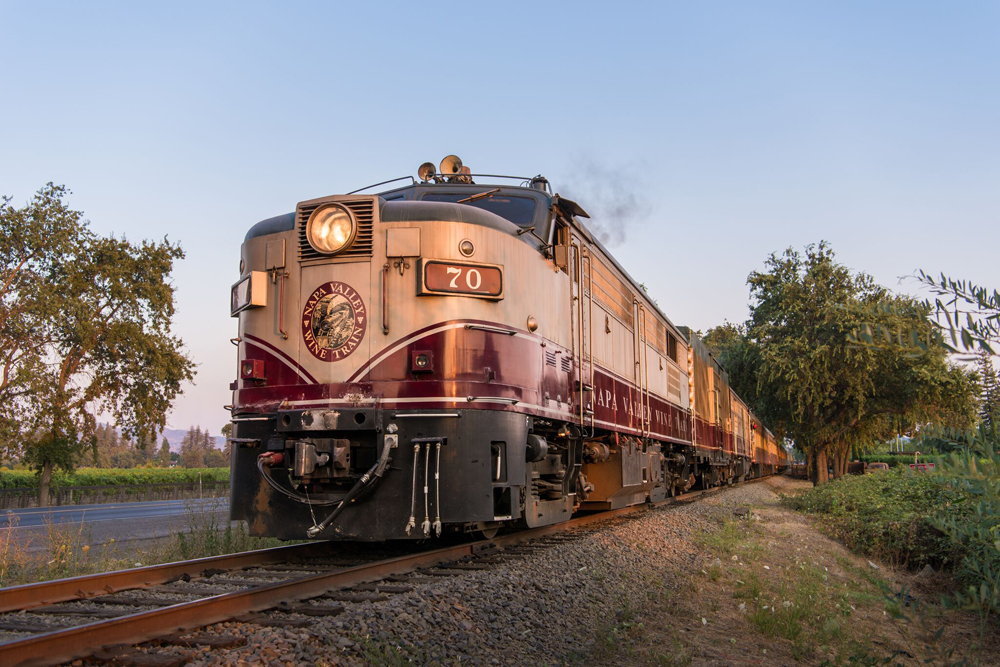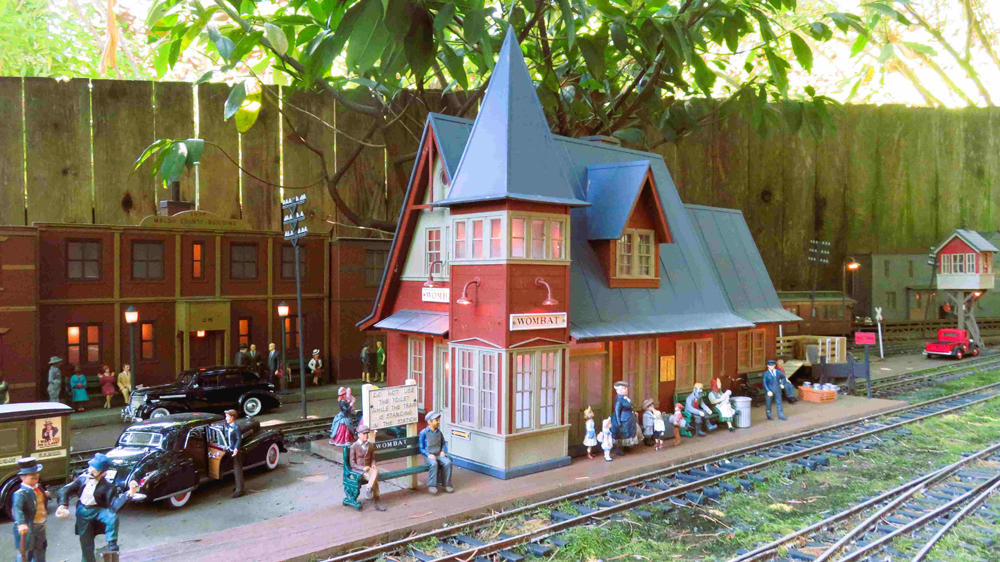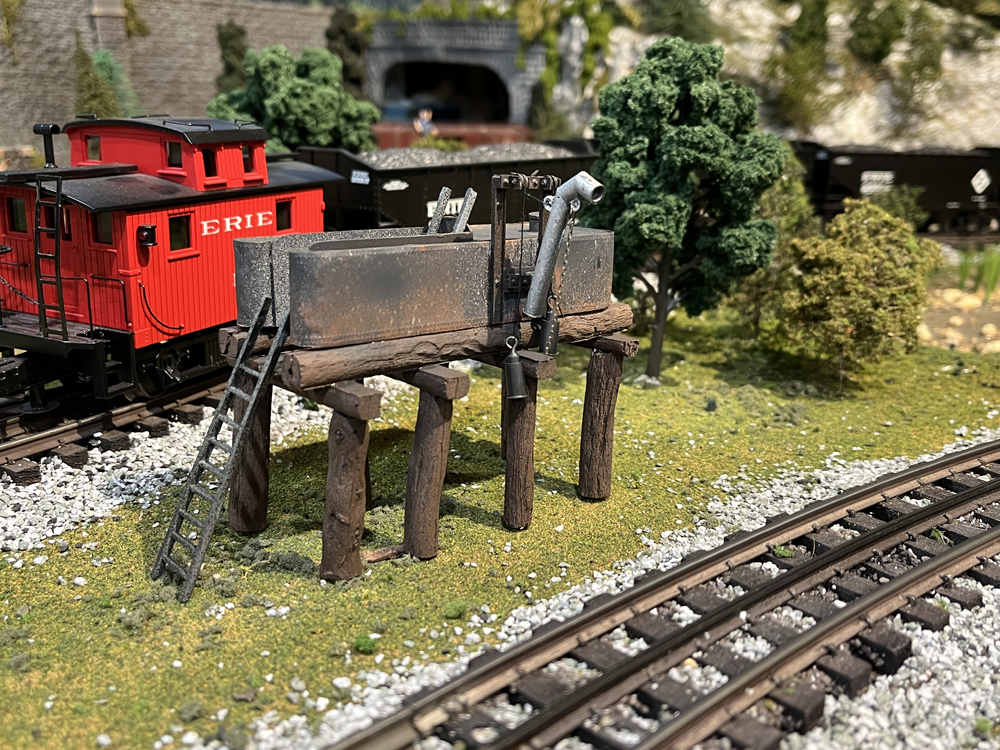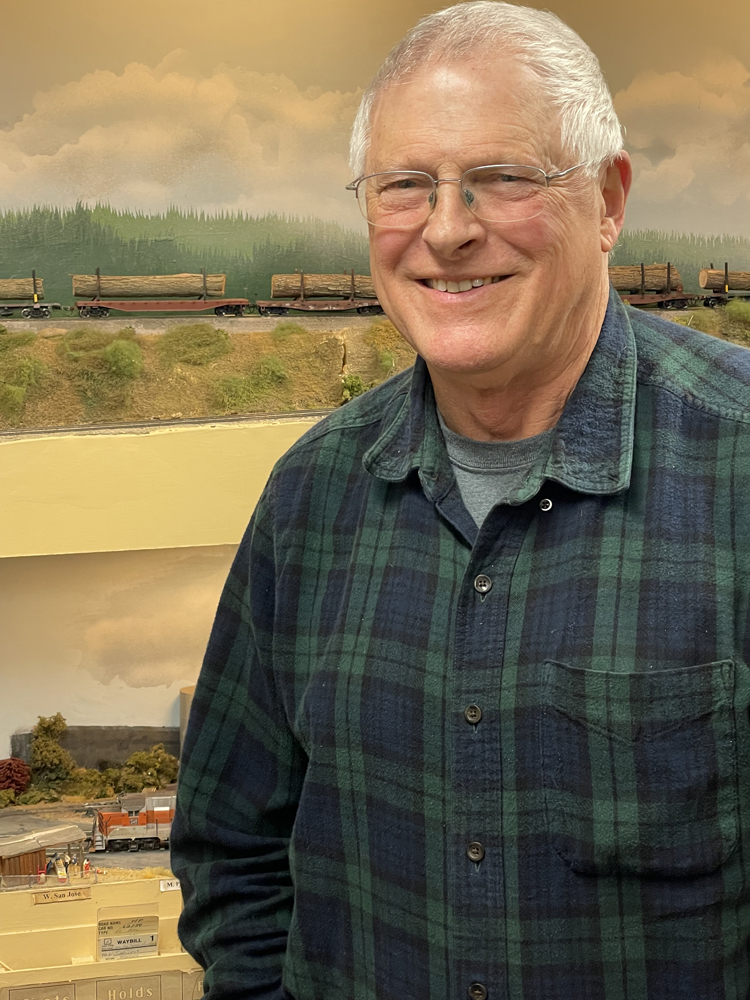
SACRAMENTO, Calif. — The California Air Resources Board has approved a grant that would allow the Napa Valley Wine Train to replace — and, under regulatory requirements, destroy — six vintage diesels with two Tier 4 compliant switchers.
The approval, which occurred earlier this year, according to the CARB website, covers two of the Wine Train’s signature ex-Canadian National, ex-VIA Rail Canada FPA4 locomotives; an ex-Southern Pacific RS11; a GP9R; an ex-U.S. Navy GE 65-ton switcher, and an ex-U.S. Air Force GE 80-ton switcher. All of the locomotives involved were built in 1959 or earlier. They would be replaced by two 1,560-hp Knoxville Locomotive Works locomotives. Napa Valley Wine Train has told the Bay Area Air Quality Management District the two new units “will be able to perform the same scope of work as the six [replaced] units, despite the overall decrease in horsepower,” according to the CARB’s approval.
Napa Valley Wine Train received more than $2 million for the locomotive replacement when federal Consolidated Rail Infrastructure and Safety Improvement Program, or CRISI, grants were announced in September [see “Federal Railroad Administration awards more than $1.4 billion …,” Trains News Wire, Sept. 25, 2023]. The CRISI announcement indicated the tourist railroad would “replace seven highly polluting locomotives with three near-zero-emission locomotives;” no explanation of the difference in figures between the state and federal documents was immediately available. Napa Valley Wine Train and the Bay Area Air Quality Management Districta are to provide 75% of the funding for the project.









there’s a petition to save these units, I’d sign if you wanna prevent them from doing this: https://www.change.org/p/prevent-the-scrapping-of-napa-valley-s-antique-alco-fpa-4s-and-rs-11-locomotives
Worst state in the country. Horrible people; worse government. The fact that they aren’t allowed to sell off the locomotives or donate them, but must in essence destroy them as functioning units is a DISGRACE. We need to forcible retake California and exile its leaders.
I guess I can take them off my list of things I want to see or do.
Did they even consider re-powering the Alcos? (almost a fate worse than death)
I think that I read somewhere that they already did.
So, if I’m understanding this correctly (which I may not be), if not cutting up these historic diesels, the engine block must be made inoperable. There’s no option whereby these units could be purchased or donated to another non-California railroad museum (or shortline that wants them) and then they could operate there?
Fortunate for Napa Valley to get taxpayer subsidized new diesels, but don’t understand what is gained by destroying perfectly good historic locomotives that should go on to another career at an alternate museum railroad.
I’m sure we are not too far away from operation of all older diesels and steam locomotives being banned in the State of California.
How about they put the Brookview diesels on the rear and leave the diabled FPA4’s at the front as “cabcars” so to speak. At least the public could still benefit from seeing the Napa Wine Train as it always has been even if a little modification has to be accepted. This is a perfect example of the results of government being unintended consequences. Wonder what California will do when they have to out law older jets, trucks and automobiles in the name of regulations that won’t solve anything. I guess the CARB doesn’t give a crap about the tourist industry in California, or the economy. No wonder people are leaving California in droves….
Sad but it’s really hard to argue keeping really old dismals operating when the government is helping you to buy bright shiny new engines that are cheaper to operate. I can only hope the Alcos find a new home where they can at worst be displayed and at best operated even if just occasionally.
You mean outside of California…
As an aside to people mourning these handsome FPA4s, I find myself on parallel Highway 29 through the Napa Valley fairly often and I haven’t seen them pulling the Wine Train in years. The road switchers seem to be doing the dirty work.
Iowa Northern should buy the FA’s and paint the in the attractive original Rock Island scheme.
New York City would have suffered the same fate as California if the mad planner Robert Moses would have gotten his way. His plan was to totally make NYC car-centric with miles of freeways and expressways and would have totally eliminated all public transit be it subways, buses and commuter rail. But thankfully cooler heads prevailed and his mad plan never fully came to pass. Some damage and elimanation came about but not on the grand scale that Robert Moses would have tried to do. California has now realized the error of their past ways but zero emissions and other green and ecco friendly methods are not going to totally reverse the damage already done. The Pacific Electric system served a vast area of Southern California, so large that even the NYC Transit system would fit right inside the PE network. Some transit and rail lines are being built and others being expanded but never will we ever see or future generations see a new PE system. The cost to create a system as large as the PE was would be impossible to duplicate and the cost would be billions by today’s prices. Also you have a new generation of folks who are so attached and in love with their cars that they would never give them up or stop driving even if a streetcar or rail line ran right outside their door to their places of business and stores. There is still a culture in California as well as other areas of this country that to be sucessful and live a good live and have that high standard that you must own a car maybe 2 or 3 cars in the family and it means also buying a new one or trading in the present one almost every year for the latest model that both car manufacturers and car dealerships pressure folks into buying one sort of what is being every year with high pressure advertising and sales to make folks buy the latest cell phone every year and get rid of a perfectly good and reliabel one that was just brand new and latest model the year before.
Joseph C. Markfelder
but how can this be early diesel locomotives can’t be polluting
California doesn’t care!
As stated below it probably doesn’t mean scrapping but disabling. Being CA was the epicenter of the car-centric culture letting an exceptional streetcar system be dismantled it seems only fitting they take the lead & set an example on the resulting environmental mayhem that was the result of this lifestyle, others states should follow their model. Regrettably, recent data & events lead one to believe that this is all too little too late.
No doubt that possibly one or two of these classic diesel locomotives will be saved and put on display somewhere in California. California does have a good record of preserving their rail history and heritage with several small towns and cities that have old locomotives and cars on display. I see this when I visit California where many of these small towns have their station preserved along with tracks that have the equipment on display. One such town is Fillmore which is proud of their railroad heritage and history. The station is preserved and outside a railroad park was created with old diesels, passenger cars and freight cars carefly preserved and on display. Even a few stores in town and one in particular sells all railroad related merchandise and gift items. I have also seen other small towns in California do the same and there is another railroad park and museum just outside of Burbank. Let’s not forget the California State Railroad Museum one of the most famous and well known of railroad museums in this country. One more note, while we have to modernize and go along with the times to stay relevant and current and same goes for railroads both Class ones as well as tourist railroads which is what the Napa Valley Railroad is, the new locomotives that are coming in to replace the fine old locomotives might be modern with all the latest technology and zero emissions and all that “green” stuff no doubt these new engines will be downright ugly and boxy looking with no graceful or stremlined ines or apperance. That is the problem with today’s new equipment be in locomotives, buses and automobiles and even the cruise ships of today just downright ugly, plain and no beauty or gracefulness to them. These old diesels like the classic cars of the 50s and 60s as well as the classic ocean liners of years gone by had a style and charm all of their own. Hard to see any of these new locomotives in 50 years being preserved or going into a museum or railroad park for display. No doubt either one of classic locomotives will be preserved and put on display at Napa Valley or one or two either going to a museum or even operating on some other tourist railroad in the country. Fellow railfans and train buffs Get your photos and videos in now and maybe take a ride on this train before these loomotives pass into history or hopefully not the scrapyard or the torch.
Joseph C. Markfelder
Tier 4 locomotives, nor any new vehicle of any stripe, is “zero emission.” The new locos have lower NOx and particulate emissions through engine/tailpipe design and lower CO2 exhaust by increased efficiency. Lower? Yes. Good. Zero? No. Not thermodynamicly possible.
Blasphemy.
Terrible news. Can “destroy” be satisfied by destroying the diesel engine? Someone has to rescue these locomotives.
In theory “destroy” means rendering the engine block unusable by scraping or damage enough so as to never be used again. See the F59s in auction from Metrolink with holes torched in the blocks of the prime mover and HEP plant.
Typical Californication BS. They have convinced themselves that they alone can save the world by making Cal. “dark green”, solar, windmills, battery trucks, battery cars, battery trains. None of those are actually green. Send the locos to a museum somewhere, they won’t pollute in calif anymore and some might enjoy looking at history. Oh, wait, calif is outlawing history too, I forgot. Rail history is just as important as California’s selective/pretend history.
Even in ultra-green Colorado you can ride a tourist train with a creepy old diesel from before the dawn of polution control tiers.
Was there a change in management or ownership? Some patrons who ride the Napa Valley Wine Train came because of the MLW FPA4’s as well as the wines and meals served.
The short term gain of more than $2 million incentive to destroy and trade for 4-tier diesel locomotives will ruin its reputation as a heritage site and possibly reduce ridership with one less reason to visit.
CARB doesn’t care about that. They have regulations to write… lol!
Have you considered that the operator wants to replace its 63+ yo locomotives with NEW ones which are paid for by taxpayers. This is simply corporate welfare, not environmental activists demanding the new locomotives. When free money is available, most will grab the money and run.
Of course you are absolutely correct (speaking as retired railroad mechanic). New stuff is (usually) easier/cheaper to maintain than old stuff. It’s the overreaching zeitgeist that we have to destroy the past to move into the future that’s worrisome. What next? Scrap the last remaining SP cab-forward just to make sure it never steams again?
Why destroy them? Preserve without running them! Some museum must have enough money for at least one of the FPAs, no?
History to be sacrificed on the altar of political correctness.
That’s what “environmentalists” do. They destroy.
The greenies harm the environment.
What history is being sacrificed? If you are referring to the FPA locomotives, they are originally Canadian, not Californian, locomotives. There is still plenty of California rail history preserved at the California State Rail Museum, Yosemite Sugar Pine Railroad, Western Pacific Railroad Museum in Portola, San Francisco heritage streetcars and cable cars, Southern California Railway Museum, Laws Railroad Museum & Historical Site, and the Niles Canyon Railway.
The FPAs have been a staple in the Napa Valley for 35 years. They are as much of the Golden State landscape as the Golden Gate Bridge, Hollywood & Vine and that unmistakable smell of urine one whiffs as soon as exiting LA Union.